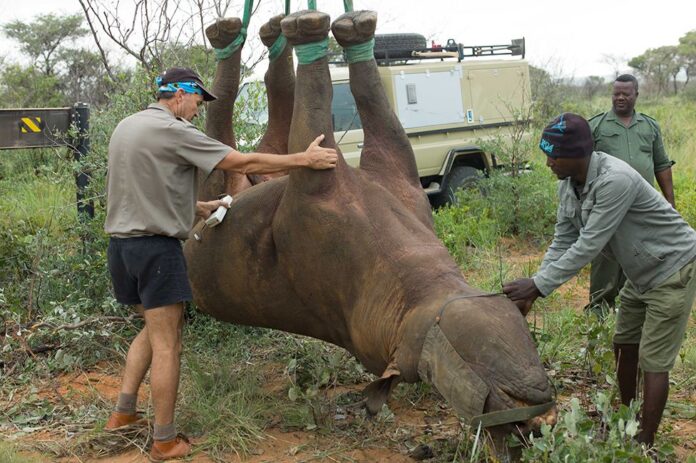
A group of scientists studying the effects of hanging a rhinoceros upside down have won a cash prize of a counter 10 trillion dollar Zimbabwean bank note in this year’s Ig Nobel Prize.
According to the BBC, no-one had done the basic investigation to determine how this would affect the animal.

The black rhino is critically endangered, predominantly due to significant demand for rhino horn and conservationists have been finding ways to better protect them for a number of years.
Sometimes the rhinos need to be moved from inaccessible, wilderness areas by helicopter, to bring them to safety.
But as transporting the enormous creatures can be a tricky manoeuvre, the rhinos need to be tranquilised.
The World Wildlife Fund has indicated that this allows them to be airlifted by their feet, which saves time and is thought to be kinder to the animals.
The Ig Nobel Prize is a satiric prize awarded annually since 1991 to celebrate ten unusual or trivial achievements in scientific research, its stated aim being to “honor achievements that first make people laugh, and then make them think.
Recipients of Ig Nobel Prizes included teams that studied the bacteria in chewing gum stuck to pavements, and how to control cockroaches on submarines.
The spoof prizes are not as famous as the “real” Nobels – not quite.
The BBC further reports that the ceremony couldn’t take place at its usual home of Harvard University in the US because of Covid restrictions with all the fun occurring online instead.
The science humour magazine, Annals of Improbable Research, says its Ig Nobel awards should first make you laugh but then make you think.
And the rhino study, which this year wins the award for transportation research, does exactly this. What could seem moredaft than hanging 12 rhinos upside down for 10 minutes?
The BBC further reports that wildlife veterinarian Robin Radcliffe, from Cornell University, and colleagues di the experiment in Namibia because they wanted to know if the health of the animals might be compromised when slung by their legs beneath a helicopter.
It’s an activity that increasingly has been used in African conservation work to shift rhinos between areas of fragmented habitat.
However, no-one had done the basic investigation to check that the tranquillised animals’ heart and lung function coped with upside-down flying, said Robin.
He told BBC News: “Namibia was not the first country to move rhinos upside down with helicopters, but they were the first to take a step back and say, ‘hey, let’s study this and figure out, you know, is this a safe thing to do for rhinos?’”
And so, his team, in collaboration with the Namibian Ministry of Environment, Forestry, and Tourism, suspended 12 tranquillized black rhinoceroses by their feet from a crane, and measured their physical responses.
It’s actually better for the rhino to be held by its ankles than put on its side
It turns out, the animals coped very well. In fact, there was evidence the rhinos did better in this unusual position than simply lying chest down or on their side.
“I think the reason for that is, when a rhino is on its side, you have positional effects of blood flow. So in other words, the lower parts of the lung are getting lots of blood flow for gas exchange, but the upper part of the lung, just because of gravity, is not getting perfused well, so when a rhino is hanging upside down, it’s basically like it’s standing upside up; the lung is equally perfused.
“We’ve also seen that rhinos that are on their side too long, or on their sternum, especially – they get muscle damage, they get myopathy, because they’re so heavy. And there’s no pressure on their legs, other than the sense of the strap around their ankle,” Robin explained.
As has become customary with the Ig Nobels, the prizes on the night were handed out by real Nobel laureates, including Frances Arnold (chemistry, 2018), Carl Weiman (physics, 2001), and Eric Maskin (economics, 2007).
The winners got a trophy they had to assemble themselves from a PDF print-out and a cash prize in the form of a counterfeit 10 trillion dollar Zimbabwean banknote.
Asked what he’d do with his “cash” payout, Robin Radcliffe told the BBC with a chuckle: “We are always looking for grant funding.
“When I first heard about the Ig Nobel, I wasn’t sure if this was good or bad. But I think that message that ‘it makes you laugh and then think’ – this is what it’s about for us. More and more people should understand what efforts are going on to try to help save these amazing animals that live here on Planet Earth with us.”
Team-member and wildlife doctor Pete Morkel added: “This has really changed rhino translocation, and even more so elephant translocation. Picking these big animals up by their feet – it’s now accepted. The next thing we’ve got to do is some research on other species like buffalo, hippo, and maybe even giraffe.”
The full list of 2021 Ig Nobel award winners:
Biology Prize: Susanne Schötz, for analysing variations in purring, chirping, chattering, trilling, tweedling, murmuring, meowing, moaning, squeaking, hissing, yowling, howling, growling, and other modes of cat-human communication.
Ecology Prize: Leila Satari and colleagues, for using genetic analysis to identify the different species of bacteria that reside in wads of discarded chewing gum stuck on pavements in various countries.
Chemistry Prize: Jörg Wicker and colleagues, for chemically analysing the air inside movie theatres, to test whether the odours produced by an audience reliably indicate the levels of violence, sex, antisocial behaviour, drug use, and bad language in the movie the audience is watching.
Economics Prize: Pavlo Blavatskyy, for discovering that the obesity of a country’s politicians may be a good indicator of that country’s corruption.
Medicine Prize: Olcay Cem Bulut and colleagues, for demonstrating that sexual orgasms can be as effective as decongestant medicines at improving nasal breathing.
Peace Prize: Ethan Beseris and colleagues, for testing the hypothesis that humans evolved beards to protect themselves from punches to the face.
Physics Prize: Alessandro Corbetta and colleagues, for conducting experiments to learn why pedestrians do not constantly collide with other pedestrians.
Kinetics Prize: Hisashi Murakami and colleagues, for conducting experiments to learn why pedestrians do sometimes collide with other pedestrians.
Entomology Prize: John Mulrennan Jr and colleagues, for their research study “A New Method of Cockroach Control on Submarines”.
Transportation Prize: Robin Radcliffe and colleagues, for determining by experiment whether it is safer to transport an airborne rhinoceros upside down.














